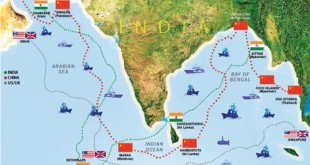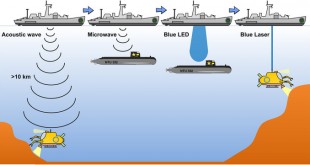Autonomous vessels are one of the newest things in marine technology and many large organizations and companies are currently researching and testing unmanned vessels. There is a possibility that in a few years we will see unmanned vessels sailing in international waters.
US Navy recently launched a fully autonomous, 132 feet long vessel that can operate for months in a row without a crew. The vessel is able to operate completely without human interaction and make collision avoidance decisions based on the Convention on the International Regulations for Preventing Collisions at Sea (COLREGS). One of Chinas largest ship building companies plans to launch its first smart ship, a 38 800 dwt bulk carrier, in the year 2017. The smart ship will be using a whole ship information system, which enables data sharing between all systems on the ship. According to the developers, it will be designed for remote monitoring, support, management and control, using shore-based resources.
In the European Union there are currently two big projects concerning autonomous vessels. SARUMS is funded by the European Defence Agency (EDA) and stands for Safety and Regulations for European Unmanned Maritime Systems. The objective of SARUMS, according to their mission statement, is to provide a safety framework for
unmanned vessels that recognizes their operational usage, legal status and the needs of navies. (European Defence Agency). MUNIN is an abbreviation of Maritime Unmanned Navigation through Intelligence in Networks and it is an EU-funded project that consists of eight partners with various scientific and technical backgrounds. Compared to SARUMS, MUNIN focuses more on the practical side of the problem and aims to develop technical and practical solutions needed to make autonomous vessels a reality.
The AAWA (Advanced Autonomous Waterborne Applications) project is a Finnish project funded by Tekes (Finnish Funding Agency for Technology and Innovation) which aims to explore the economic, social, legal, regulatory and technical factors that will be needed to make autonomous ships a reality. AAWA is made in collaboration with Finnish research institutions and leading members of the maritime cluster, such as Rolls-Royce and Inmarsat.
One of the biggest challenges with autonomous vessels may be to get the regulations to approve of unmanned vessels in traffic. International Maritime Organization (IMO) is a specialized agency of the United Nations, which is responsible of creating international conventions and regulations regarding maritime safety, security and environmental protection.
These vessels will still have to be following the navigational rules at sea. The International Regulations for Preventing Collisions at Sea 1972 (COLREGs) are published by the International Maritime Organization (IMO) and set out, among other things, the “rules of the road” or navigation rules to be followed by ships and other vessels at sea to prevent collisions between two or more vessels.
Before unmanned vessels can become a reality they need to be at least as safe as conventional manned vessels. There are many things to be considered regarding the safety of an autonomous vessel, such as: the ability to detect small object in the water, the ability to handle encounters with multiple ships, ability to navigate safely in coastal waters, ability to handle emergencies at sea and ability to handle breakdowns. or errors in the system. If all systems working as they are supposed to, the safe navigation of the vessel should not be a problem.
Sensor fusion is one of the key technologies for the safe navigation of autonomous vessels. Some sensors work better in certain circumstances and the goal is to combine them in an optimal way that address all weaknesses. To avoid
faulty decisions based on wrong information the data needs to come from many different sources. Different manufacturers have different solutions on how to fuse the data together and the marine industry needs to figure out how to do this the optimal way onboard a vessel. Compared to cars, ships move much slower and will have much
longer times to react to a danger and make avoidance decisions. On the other side, ships have much more inertia and react slower to steering commands. The harsh environment onboard a vessel also needs to be taken into consideration when choosing what technology should be used.
Unmanned vessels have been tested in a few projects where they have been able to follow the Collision Regulations and navigate safely without accidents. Rolls Royce are currently developing advanced system to enable unmanned vessels to navigate autonomously by the rules and avoid collisions. The RP-, SA-, CA- and SSA modules are all created to secure that unmanned vessels safely and autonomously can navigate at sea. The US-based science and technology solutions company Leidos also announces that the submarine-hunting vessel in the DARPA project has completed a successful 42 days testing period at sea, including 101 different scenarios and are able to navigate safely in both narrow channels and traffic separation schemes.
Rule one of COLREGS states that all vessels upon the high seas or waters connected there with have to comply with the Collision Regulations. In other words, all vessels sailing in sea areas beyond the limits of national jurisdiction will need to follow COLREGS. The liability in case of a collision accident is a major challenge that the shipping industry will face. Future accidents involving autonomous vessels will at least to a certain extent be caused by system failures. There are no clear answers to questions on liability for operations involving autonomous vessels yet. When can we blame the ship owner?
The fifth rule of COLREGS states that a ship must maintain a proper lookout by sight and hearing for full appraisal of the risks of collision. Unfortunately, neither direct hearing nor visual lookout will be possible for a vessel lacking a crew onboard. Well-equipped unmanned vessel with advanced radar- and sonar systems might be adequate substitutes to the human eyes and ears and meet the requirements in rule five. Automated eyes and ears could prevent us from human errors arising when you are tired, sick or fatigue.
Autonomous Ships Can Use COLREGs Effectively
Rolls-Royce has completed a research project it says demonstrates that the operation of autonomous vessels can meet, if not exceed, current collision avoidance (COLREG) rules. The MAchine eXecutable Collision regulations for Marine Autonomous Systems (MAXCMAS) project included partners Lloyd’s Register, Warsash Maritime Academy (WMA), Queen’s University Belfast and Atlas Elektronik (AEUK).
The team found that use of newly developed algorithms allowed existing COLREGs to remain relevant in a crewless environment, finding that artificial intelligence-based navigation systems were able to enact the rules to avoid collision effectively, even when approaching manned vessels were interpreting the rules differently.
Rolls-Royce Future Technologies Group’s Eshan Rajabally, who led the project, said: “Through MAXCMAS, we have demonstrated autonomous collision avoidance that is indistinguishable from good seafarer behavior, and we’ve confirmed this by having WMA instructors assess MAXCMAS exactly as they would assess the human.”
During the development project, Rolls-Royce and its partners adapted a commercial-specification bridge simulator as a testbed for autonomous navigation. This was also used to validate autonomous seafarer-like collision avoidance in likely real-world scenarios. Various simulator-based scenarios were designed, with the algorithms installed in one of WMA’s conventional bridge simulators. This also included Atlas Elektronik’s ARCIMS mission manager Autonomy Engine, Queen’s University Belfast’s Collision Avoidance algorithms and a Rolls-Royce interface.
During sea trials aboard AEUK’s ARCIMS unmanned surface vessel, collision avoidance was successfully demonstrated in a real environment under true platform motion, sensor performance and environmental conditions. “The trials showed that an unmanned vessel is capable of making a collision avoidance judgment call even when the give-way vessel isn’t taking appropriate action,” said Ralph Dodds, Innovation & Autonomous Systems Programme Manager at AEUK. “What MAXCMAS does is make the collision avoidance regulations applicable to the unmanned ship.”
The MAXCMAS technology and system has been thoroughly tested both at sea and under a multitude of scenarios using desktop and bridge simulators, says Rolls-Royce, proving that autonomous navigation can meet existing COLREG requirements.
U.S. Navy Wants its Unmanned Vessels to Make VHF Calls
The Rules of the Road (COLREGS) give clear instructions for encounters between two vessels in sight when risk of collision exists, but they do not specify what happens when three or more vessels are interacting at the same time. In everyday commerce, mariners deal with traffic of all kinds by communicating with other ships over VHF. No current unmanned surface vessel (USV) is equipped to conduct and act upon bridge-to-bridge voice communications.
As part of the U.S. Navy’s accelerating investment in unmanned systems, it is seeking proposals for an automated “bridge-to-bridge radio for unmanned surface vehicles” – a system that would give unmanned vessels the ability to talk to human mariners and make passing arrangements over VHF.
According to the Navy, off-the-shelf technologies exist to convert voice signals to into text and to convert text to machine-usable meaning. The Navy’s Unmanned Maritime Systems Program Office is looking for a complete solution that will enable a USV to act much like a human mariner – that is, to understand voice radio transmissions, incorporate their meaning into its world model, develop appropriate maneuvering plans, and respond via voice over bridge-to-bridge radio. It will accept partial solutions to the problem, but ideally it is seeking a complete package.
The acquisition plan calls for three phases. The first, a proof-of-concept phase, calls for a demonstrator system that can understand simple phrases used to make passing arrangements. At a minimum, the end product for the first phase would have to recognize common bridge-to-bridge calls as made by native English speakers. As an example, the RFP used the phrase “[USV] Sea Hunter, this is Sun Princess; propose a port-to-port passage.”
The second phase calls for an integrated prototype connected to a VHF radio. The phase two device must have extended functionality to recognize English spoken by non-native speakers, and it must be able to generate English phrases of its own to reply to calls. Phase two calls for (but doesn’t require) adding functions to integrate the system with an autonomous vessel’s COLREGS reasoning and world model.
In phase three, the selected contractor will integrate the system with an autonomous navigation reasoning engine. It will also help the Navy transition the technology to real-world use. The technology will be used in the Navy’s Medium Unmanned Surface Vehicle (MUSV) program, the Large Unmanned Surface Vehicle (LUSV) program and possibly other USV programs. The RFP also mentioned the potential for civilian applications aboard unmanned merchant vessels and aboard manned pleasure craft “as an aid to a human operator.” Though not always used in practice, the ship’s whistle is the legally recognized system for making passing arrangements under COLREGS.
References and Resources also include:
https://www.maritime-executive.com/article/u-s-navy-wants-its-unmanned-vessels-to-make-vhf-calls
https://www.maritime-executive.com/article/autonomous-ships-can-use-colreg-rules-effectively
 International Defense Security & Technology Your trusted Source for News, Research and Analysis
International Defense Security & Technology Your trusted Source for News, Research and Analysis

